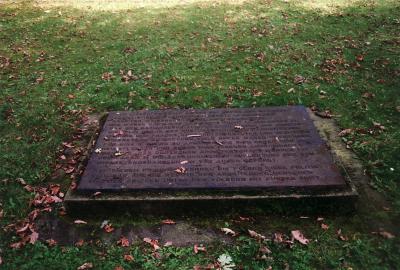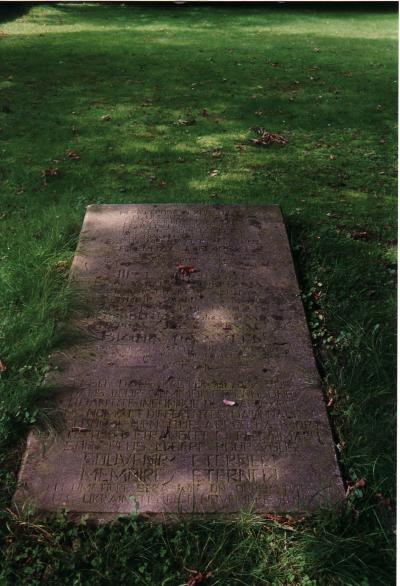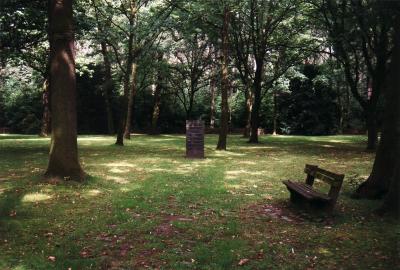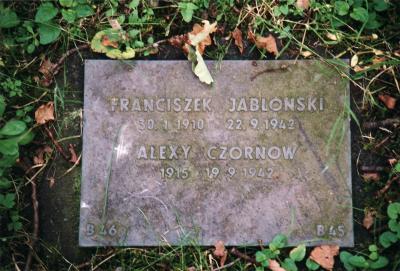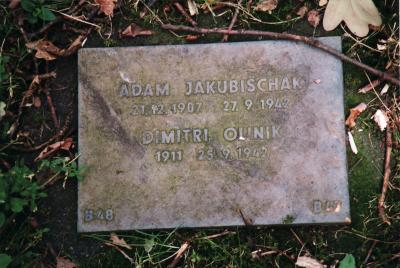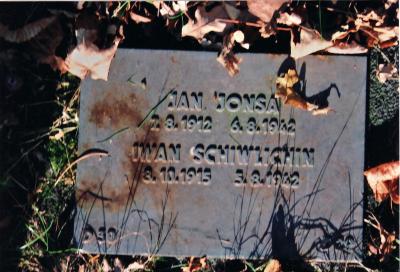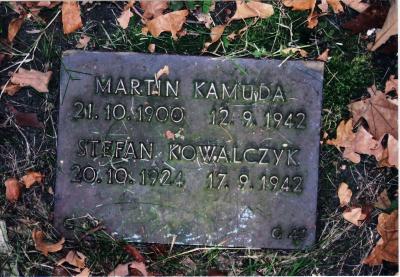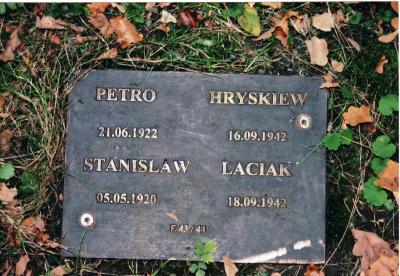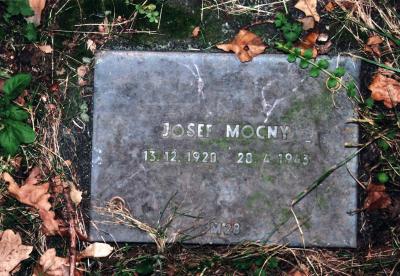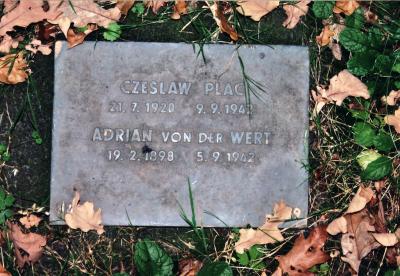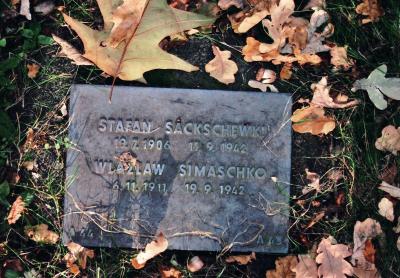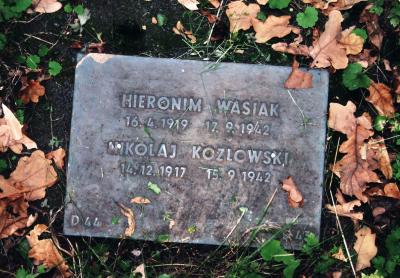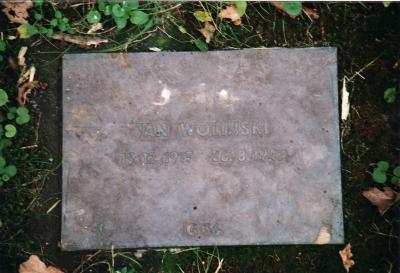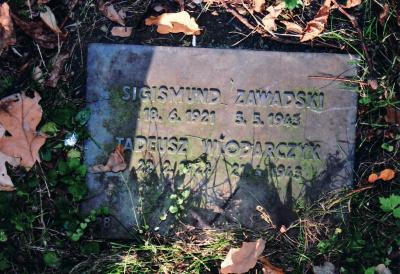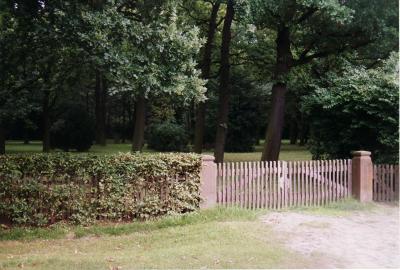Salzgitter Hallendorf
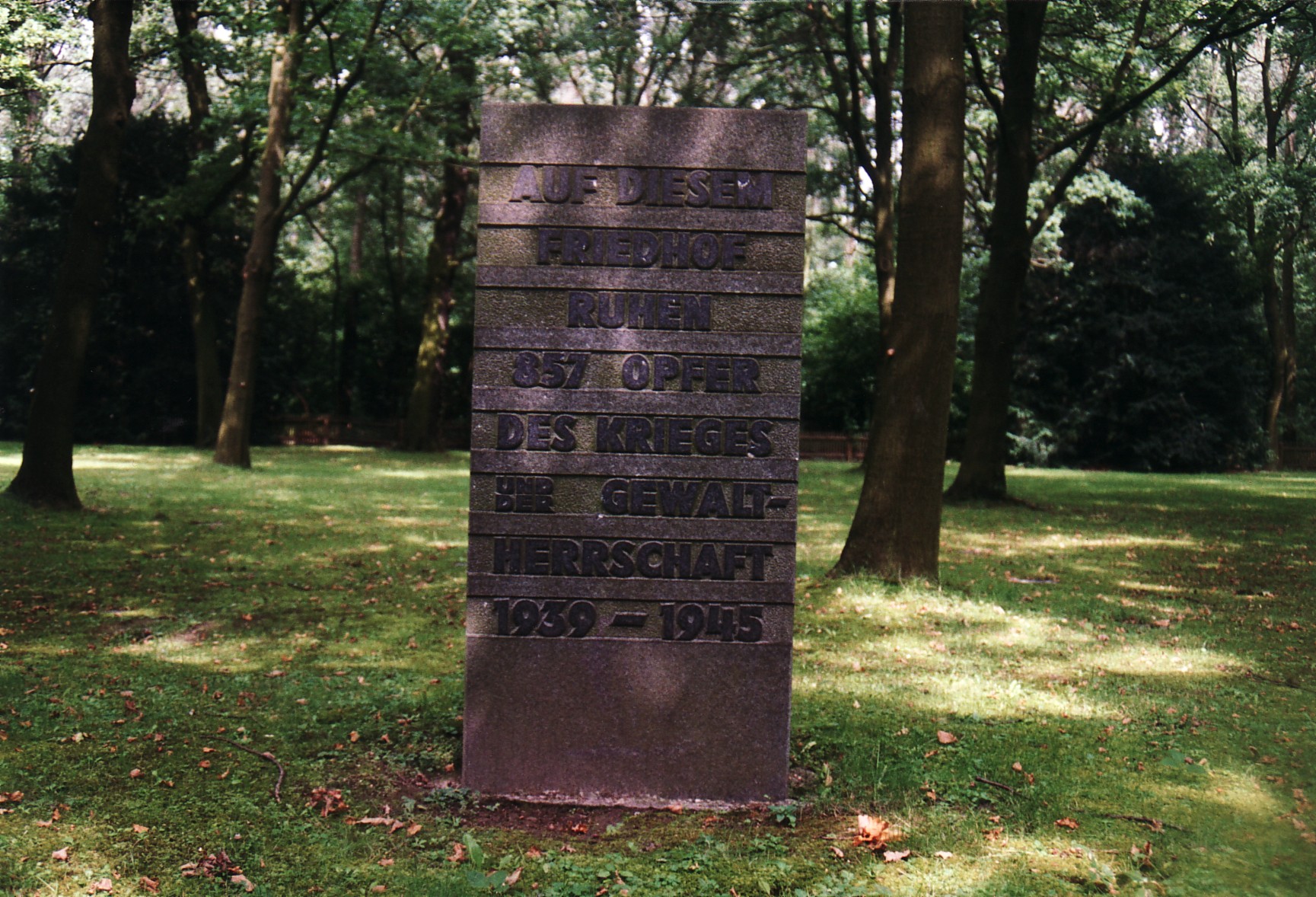
Until the outbreak of World War II Westerholz war cemetery was a Catholic communal cemetery. Until today, there are over a dozen graves of Hallendorf inhabitants on both sides of the necropolis. Until mid-1943, it was used as a camp cemetery and after there was no more place there, the corpses were buried at the newly established Jammertal cemetery. In November 1945, former forced labourers from Ukraine commemorated their compatriots with a memorial plaque, situated directly on the ground to the left of the entrance, with an inscription in Ukrainian, Russian and English:
HERE, UNDER 806 BARROWS
LIE SEVERAL HUNDRED ANONYMOUS
MARTYRS OF VARIOUS NATIONALITIES.
MAY THEM REST IN PEACE
IN THIS HOSTILE GROUND!
ETERNAL REMEMBRANCE AND GLORY!
UKRAINIAN CEMETERY
1 NOVEMBER 1945 [translated from Polish]
On the right-hand side of the entrance there is a metal plate based on a concrete foundation with an inscription in German:
AUF DIESEM FRIEDHOF LIEGEN 857 OPFER DES NATIONAL-
SOZIALISTISCHEN HERRSCHAFTSSYSTEMS BEGRABEN: ARBEITER, KRIEGSGEFANGENE, ZWANGSARBEITER. SIE WAREN HÄFTLINGE DES STRAF- UND TODESLAGERS 21, DAS DEN NATIONALSOZIALISTEN DAZU DIENTE, DIE ARBEITSDISZIPLIN DER IN DER RÜSTUNGSPRODUKTION ARBEITENDEN MÄNNER UND FRAUEN AUFRECHTZUERHALTEN UND JEGLICHEN WIDERSTAND ZU BRECHEN, VIELE OPFER WAREN GEZWUNGEN, FÜR EINE RÜSTUNG ZU ARBEITEN, DIE SICH GEGEN IHRE HEIMATLÄNGER UND GEGEN IHRE EIGENEN ANGEHÖRIGEN RICHTETE, DER DEUTSCHEN ARBEITERSCHAFT WURDEN MIT DEM LAGER 21 DIE GEFAHREN EINER AUFLEHNUNG UND VON WIDERSTANDSHANDLUNGEN VOR AUGEN GEFÜHRT.
AUF DIESEM FRIEDHOF WERDEN DIE FOLGEN EINER POLITIK SICHTBAR, DIE DIE RECHTE DER ARBEITENDEN MENSCHEN UND DEN FRIEDEN UNTER DEN VÖLKERN MIT FÜSSEN TRITT.
There are 875 victims of the Nazi regime buried at the cemetery: labourers, prisoners of war, forced labourers. They were prisoners of penal camp 21 and of a death camp, which was used by the Nazis to keep discipline and to break the resistance of men and women working for the arms industry. Many victims were forced to produce weapons, which were later used against their home countries and their closest relatives. Camp 21 showed German labourers how resistance against the system could end.
The cemetery is an evidence showing the effects of the policy of violating the rights of working people and peaceful coexistence of nations.
Until the 1980s, the necropolis and corpses buried there were totally forgotten and neglected. In November 1983, for the first time after the war ended, on the day of remembrance of war victims a plaque with the following inscription was unveiled:
AUF DIESEM
FRIEDHOF
RUHEN
857 OPFER
DES KRIEGES
UND DER GEWALT-
HERRSCHAFT
1939–1945
AT THIS CEMETERY REST 857 VICTIMS OF THE WAR AND DESPOTISM OF 1939–1949.
In 2003, the cemetery was tidied up, some renovation works were also carried out and the plates on the graves, that had been stolen or destroyed, were restored.
Special camp No. 21 was the worst labour camp in Salzgitter and its surroundings. Its purpose was to suppress any sort of resistance, which in several hundred cases was done by murdering the prisoners. The creation of the camp was directly related to a constantly growing number of Polish forced labourers and their attitude towards discriminating regulations of March 1940, restricting all the rights (the so called Polenerlass: every employer, guard or citizen of the Reich had the right to accuse Poles or inform against them and other forced labourers), according to which Poles only had the right to slave labour, in this particular case - for the Third Reich arms industry. Poles reacted with passive resistance and boycotting German orders, as a result of which Göring commanded to use even more severe sanctions against them. In spring 1940 the management of the Reichswerke-Hermann-Göring facility handed over the area with barracks to Gestapo and a penal camp was created there for Poles who evaded work or whose work was not efficient enough. Political opponents of the Nazi regime were also kept and killed there. On the 28th of May 1941, when penal labour camps for Poles were already operating by several factories or police headquarters, Himmler, under a decree, included them in the SS system of repression and crime as Arbeitserziehungslager ‒ work education camps. In 1942, it was extended by a section for women.
The camp was prepared to accept 300–400 prisoners. Ultimately, however, in 1942 1,400 men were kept there, and in the following year - 1,800 men plus 400–600 women. Because of the SS murderous penal system, until April 1945 28,000 men and 7,000 women from Poland, Czech Republic, France, Belgium, the Netherlands, Denmark, Russia, Italy and Germany were kept in the camp. Even 12-year-old children were imprisoned there and the oldest prisoner was 80 years of age. They did not spare pregnant women either. The average sentence was from 3 to 8 weeks, but some were for the period of 6 months and even for over 12 months. The rooms were 6 by 8 metres and they included 24 wooden bunks that had to suffice for 80–90 people. Two people slept on a single bunk, the rest had to sleep on the floor. At the beginning, every prisoner had one blanket, but from 1944 they practically did not distribute blankets nor clothes there and the prisoners worked in worn out and dirty civil or work clothing that they also slept in. In winter every room received a bucket of coal; this amount of fuel was not enough even for an hour's warmth. There were 2 showers for 19 rooms and warm water was rare. People were always cold and dirty, many of them suffered from frostbite, and since staying in the hospital prolonged their stay in the camp for the same period that they did not work, very few would go to see the doctor willingly. Medical supplies were disastrous: in years 1943–1944, when the camp doctor was SS-Obersturmbannführer dr Garding, 720 prisoners died.
The prisoners were divided into two groups. Majority of them referred to as Bummelanten ‒ loafers, were people sentenced for minor offences for several weeks of education through labour and beating. After they served their sentence, beaten and skinny, they usually returned to their previous jobs. If, however, they were selected for transportation to one of the concentration camps, their stay was prolonged until the transport was full and ready to go, which could even last several months. The other group, referred to as die Blauen - the blue ones (from the colour of their prison clothes) was composed of people sentenced by Gestapo outside any laws, even the atrocious laws of the Third Reich. The reason for receiving blue clothes and the "special treatment" label in the files could be for instance sabotaging work, listening to English ratio, making political statements or only referring to politics (jokes making fun of the Reich or the party), sexual intercourse with German women. Such persons were referred to as Todeskandidaten ‒ candidates for death. Apart from people sentenced by special courts, Braunschweig Gestapo always kept about 30 people in prison who - after devastating labour – were killed by hanging or shooting. SS guards could also shoot a labourer during work, which was recorder as "shot when trying to escape" and rewarded by a few days of leave granted to the shooter.
The list of 142 names of people murdered outside any laws whatsoever based on Gestapo sentences includes 18 Poles. All of them were special treatment prisoners in the penal camp:
1. ANTONI NAWROCKI * 13.3.1915 Warsaw † 8.7.1941, shot to death
2. JÓZEF GRUDZIEŃ * 21.7.1918 † 22.7.1941, shot to death
3. WAWRZYNIEC CELJOCKI * 8.8.1909 Seidluw † 13.10.1941, shot to death
4. STANISŁAW WOJCIESZKOWSKI * 10.9.1902 † 26.10.1941, accident?
5. STANISŁAW NOWAKOWSKI * 5.4.1915 Iwanowice † 10.1.1942, hanged
6. MARIAN GIERCZ * 29.11.1922 Tarnów † 4.4.1942, shot to death
7. WŁADYSŁAW SŁOTA * Sosnowiec † 16.4.1942, shot in the abdomen
8. FRANZ CAPEKAVER (Kapekafer?) * 29.9.1908 Mikoliczyn † 29.5.1942, hanged
9. JÓZEF LIPIŃSKI * 18.5.1918 Dobryninski † 7.7.1942, suicide?
10. JAN CZYŻ * 1.2.1905 Lipowce † 13.8.1942, suicide by hanging?
11. TADEUSZ SZYMAŃSKI * 5.1.1926 Plikau † 15.9.1942, shot to death
12. KAROL BOBA * 1.12.1922 Ratoszyn † 16.11.1942, shot to death
13. JÓZEF RATAJCZYK * 31.3.1903 Sobiczewo † 16.11.1942, shot to death
14. MARIAN RYŚ * 12.9.1923 Lipno † 16.11.1942, shot to death
15. WŁADYSŁAW MITAS * 3.5.1901 Tomkowice † 25.11.1942, shot to death
16. KAZIMIERZ STANISŁAWSKI * 18.1.1913 † 19.3.1943, shot to death
17. CIEŚLAK * 4.5.1920 † 4.4.1944, shot to death
18.TADEUSZ WOLNICKI * 12.10.1914 Radomsk † 12.12.1944, death by drowning.
